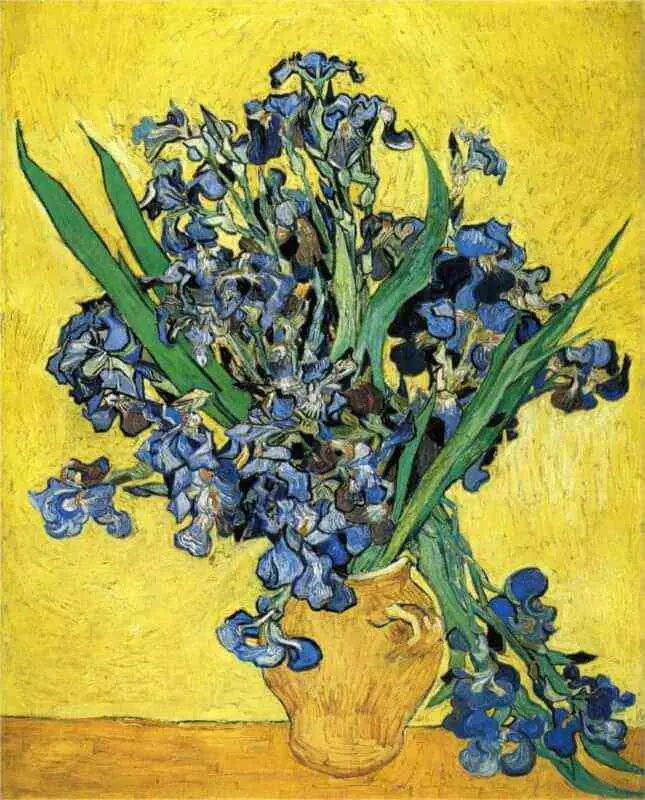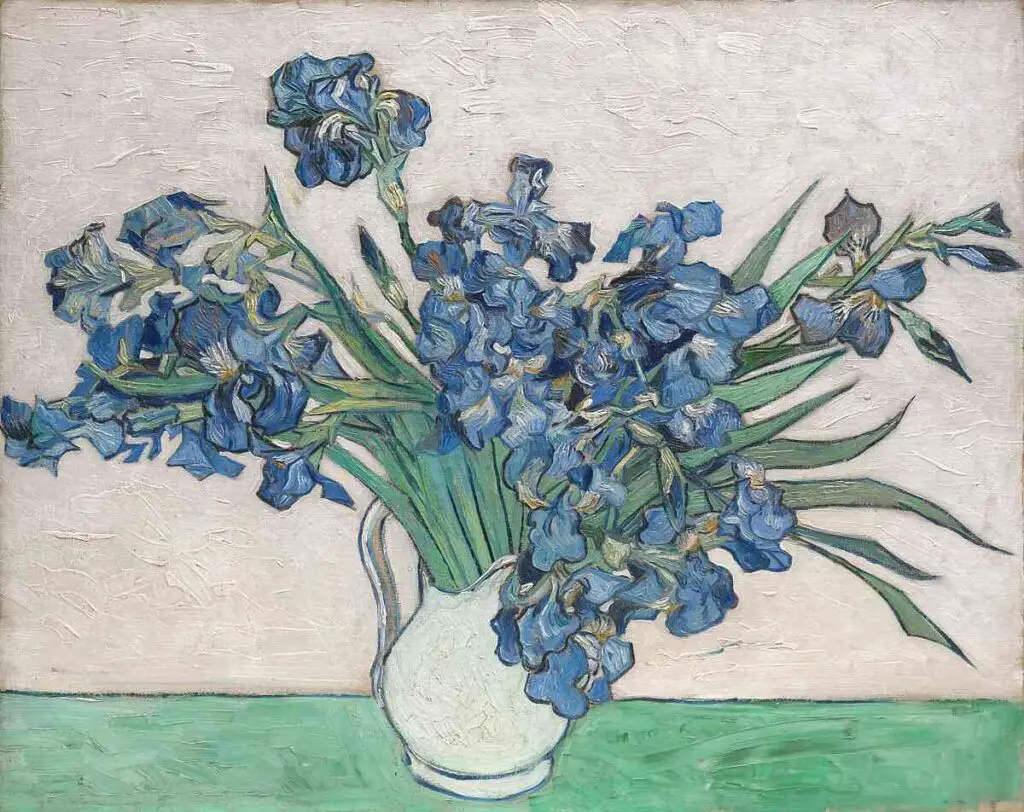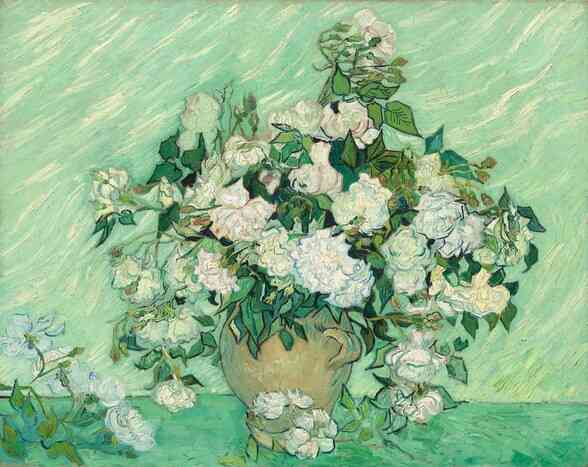As an art enthusiast, discovering the beauty of Van Gogh’s work can be a truly mesmerizing experience. Every brushstroke and color combination he used contributed something unique to his works, most notably in his painting Irises – arguably one of his finest pieces.
One of the most famous iris paintings that people talk about is van Gogh’s Irises, which are blue against a yellow background. But van Gogh also, at the same time, painted a second iris, which had a pink background. He also painted some roses with a green background at the same time. We know from his letters that these paintings for him were a study of using color combinations.
Table of Contents
- About The Irises By Vincent Van Gogh 1889 (Yellow Background)
- The Two Iris And Rose Paintings Were A Study In Color
- Frequently Asked Questions
- Related Questions

About The Irises By Vincent Van Gogh 1889 (Yellow Background)
The Irises of Vincent van Gogh are one of history’s most iconic and celebrated art pieces. Created in 1889, the painting was completed during a great personal struggle for van Gogh, who had recently been admitted to an asylum in Saint-Rémy-de-Provence.
In a letter to his brother Theo, Vincent van Gogh said this about the Iris paintings:
“On the contrary, the other violet bouquet (ranging up to pure carmine and Prussian blue) standing out against a striking lemon yellow background with other yellow tones in the vase and the base on which it rests is an effect of terribly disparate complementaries that reinforce each other by their opposition.”
Letter From Vincent Van Gogh To Theo Van gogh – 11 May 1890
We learn from this writing of Van Gogh to his brother Theo that he was using his painting of these Irises as a kind of study and color. He wanted to see how the purple and blue flowers would stand against a yellow background.
In fact, in this painting, he purposely made the background and the vase to be a similar color for the flowers to stand out.
In the original painting, the Irises were purple, but as the paint’s pigment has changed over time, the Irises are now blue. You can see the original of this painting at the Van Gogh Museum in Holland.
The Two Iris And Rose Paintings Were A Study In Color
In May 1890, Vincent van Gogh was still at the Saint-Remy de Provence Asylum. He was about ready to leave, but before he did, he did several studies of flowers—two of them were Iris, and one was a Rose.
We learn this from a letter to his brother Theo about these three paintings.
At the moment the improvement is continuing, the whole horrible crisis has disappeared like a thunderstorm, and I’m working here with calm, unremitting ardour to give a last stroke of the brush. I’m working on a canvas of roses on bright green background2 and two canvases of large bouquets of violet Irises, one lot against a pink background in which the effect is harmonious and soft through the combination of greens, pinks, violets.3 On the contrary, the other violet bouquet (ranging up to pure carmine and Prussian blue) standing out against a striking lemon yellow background ….These canvases will take a good month to dry, but the man who works here 5 will take care of sending them after my departure.
Letter From Vincent Van Gogh to Theo Van Gogh – 11 May 1890
I’m planning to leave as soon as possible this week, and I’m starting to pack my trunk today.
Many have supposed that Iris has had some special meaning to him. But in the letters to his brother, he spoke about them more as a study of color and to see how the color would look against the different backgrounds.
Vincent Van Gogh Two Iris Paintings
Vincent Van Gogh used these paintings as a study of color. There are two Iris paintings as follows:

- Irises With A Yellow Background – Irises By Vincent Van Gogh

- Irises With A Pink Background – Irises By Vincent Van Gogh
What can be very confusing about these two paintings is they are both called Irises and were painted at the same time and in the same year. There is essentially both the same size.
The irises with the yellow background can be found at the van Gogh Museum in Holland, and the Irises with the pink background are found at the Metropolitan Museum of Art in New York City.
Vincent Van Gogh Roses Painting

Also included in these studies were Roses against a bright green background. The roses with a bright green background and the Irises were simultaneously painted. The name of this painting is simply Rose, By Vincent Van Gogh, 1890, or Roses in a Vase, 1890. This painting can be found at the National Gallery of Art in Washington, DC.
What we know about these paintings is that van Gogh left the asylum before they were completely dry and asked someone to pack them up and send them to his brother Theo. We also understand that at this time, he felt he was starting to come to terms with his illness and that painting was an essential part of the healing process.
We learn from these paintings that Van Gogh had the innate ability to take a painting as simple as a vase; with flowers and make it beautiful. The flowers come to life from the canvas in each of these paintings.
They show us the skill of Vincent Van Gogh as an artist. Vincent van Gogh continues to be one of the most famous artists ever.
Anita Louise Art is dedicated to art education, great artists, and inspiring others to find and create their art. We love art that uplifts and inspires. #ArtToMakeYouSmile! #ArtToMakeYouHappy!
If you are interested to see any of my art, you can find out more by clicking here. If you are interested in what inspires me and my paintings, you can discover more by clicking here.
We have a free newsletter and would love you to be part of our community; you can subscribe to the newsletter by clicking here. If you have any questions, I would be happy to talk to you anytime. You can reach me, Anita, by clicking here.
Subscribe to our Anita Louise Art YouTube Channel with great videos and information by clicking here.
Join us for our podcast “5 Minutes With Art.” Spend just 5 minutes a week with us to discover and learn about great art and artists. You can find out more about our podcast by clicking here.
Frequently Asked Questions
What is “Guide to the Irises” by Vincent van Gogh?
“Guide to the Irises” is a famous painting by Vincent van Gogh, created in 1889. It’s known for its vibrant colors and unique brushwork.
What inspired Vincent van Gogh to paint Irises?
Van Gogh painted “Irises” while he was in the Saint-Paul-de-Mausole asylum. The irises in the painting are believed to represent his appreciation for nature.
Where can I see the original “Guide to the Irises” painting?
The original painting is housed in the J. Paul Getty Museum in Los Angeles, California, USA.
What is the significance of “Guide to the Irises” in Van Gogh’s body of work?
The painting is considered a masterpiece and reflects Van Gogh’s distinctive style. It showcases his use of color and texture to convey emotions.
How did Van Gogh approach the creation of “Guide to the Irises”?
Van Gogh employed bold and expressive brushstrokes, using contrasting colors to bring the irises to life. His technique adds depth and energy to the painting.
Are there any hidden meanings in “Guide to the Irises”?
While interpretations vary, some art historians believe that Van Gogh used the irises as a symbol of hope and renewal during a challenging period in his life.
What makes “Guide to the Irises” different from Van Gogh’s other works?
The use of vibrant and contrasting colors, particularly the rich blues and purples, sets “Guide to the Irises” apart from many of Van Gogh’s other paintings.
How has the painting been received by art critics over the years?
“Guide to the Irises” has received positive reviews for its emotional intensity, innovative use of color, and contribution to the post-impressionist art movement.
Is there any interesting trivia related to “Guide to the Irises”?
The painting was sold in 1987 for a record-breaking price at the time, making it one of the most expensive paintings ever sold.
Related Questions
Is The Scream Based On A Screaming Van Gogh?
There is no evidence that Edvard Munch painted The Scream about Vincent Van Gogh’s life and anxiety. When the famous painting was completed in 1893, he probably did not know much about Vincent Van Gogh. The Scream is based on Edvard Munch’s experience of experiencing a sunset near the water in Olso, Norway.
By clicking here, you can learn more by reading Is The Scream Based On A Screaming Van Gogh?
The Starry Night Original By Vincent Van Gogh
The Starry Night is one of Vincent Van Gogh’s most important paintings. The Starry Night is such a powerful piece of art as it shows how Van Gogh could produce paintings filled with imagination and emotion. He could produce these paintings even during some of his darkest hours when he was treated for his mental illness.
By clicking here, you can learn more by reading The Starry Night Original By Vincent Van Gogh.
Almond Blossom By Vincent Van Gogh
Almond Blossom by Vincent van Gogh is a painting that he painted for his brother Theo and sister-in-law, Jo, to celebrate the birth of their son Vincent Willem. Vincent Van Gogh painted the Almond Blossom painting in hopes that Vincent Willem would have the painting in his bedroom. The Almond Blossom painting shows the influence of Japanese Woodblock prints on Van Gogh’s artwork.
You can learn more by reading Almond Blossom By Vincent Van Gogh? by clicking here.

